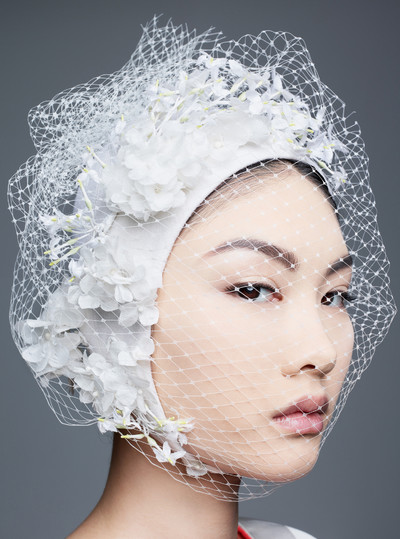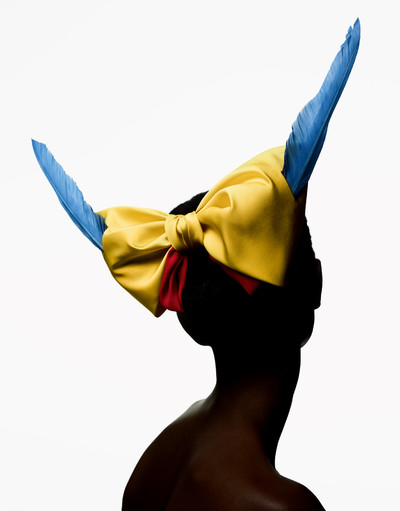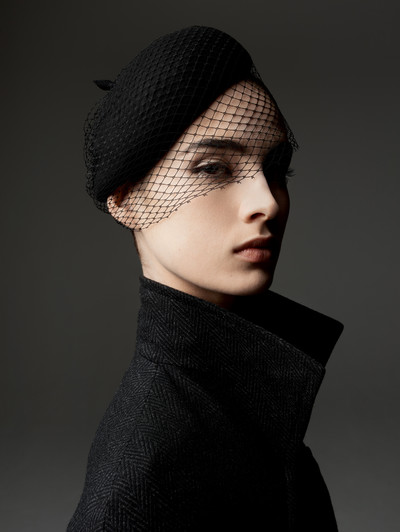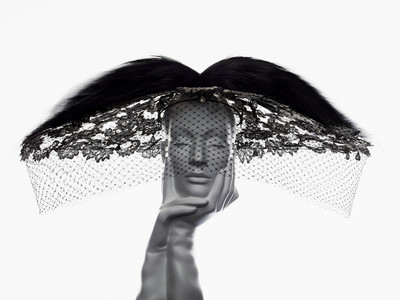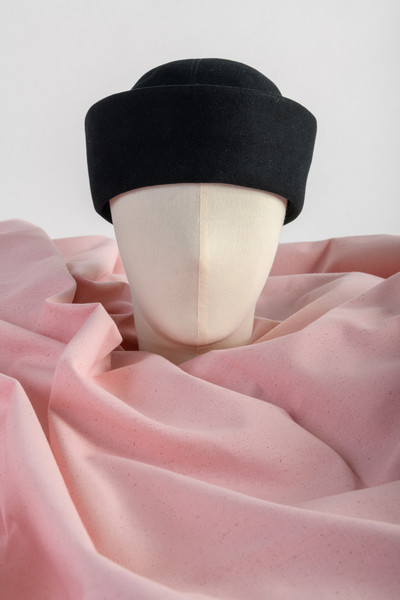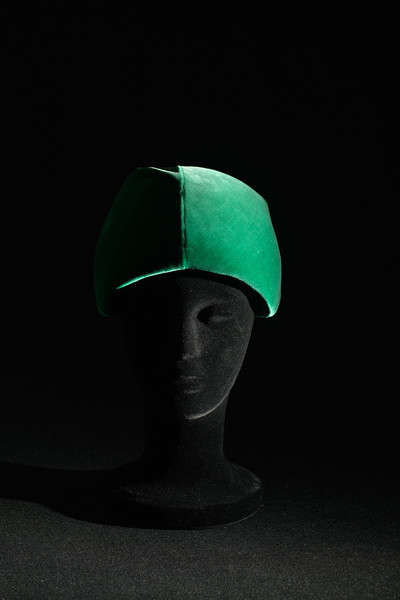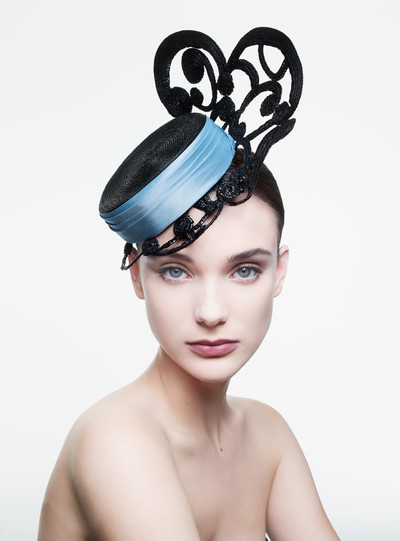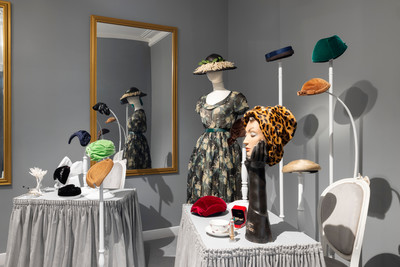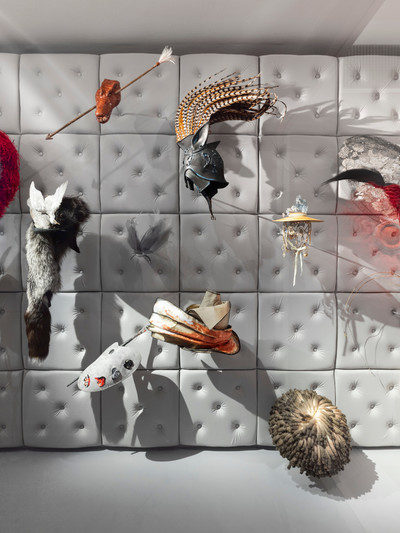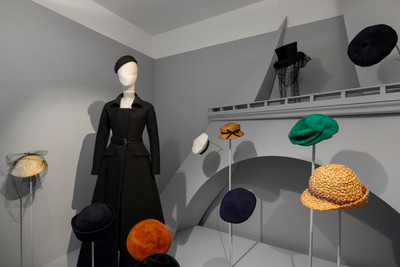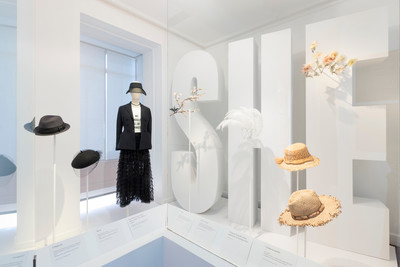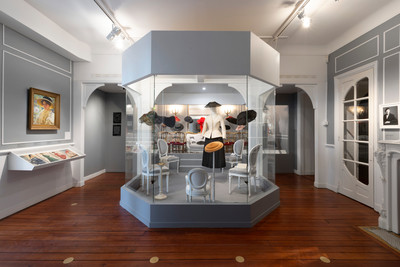A feather in his cap – celebrating 25 years of Dior hats with master milliner Stephen Jones.
By Rahim Attarzadeh
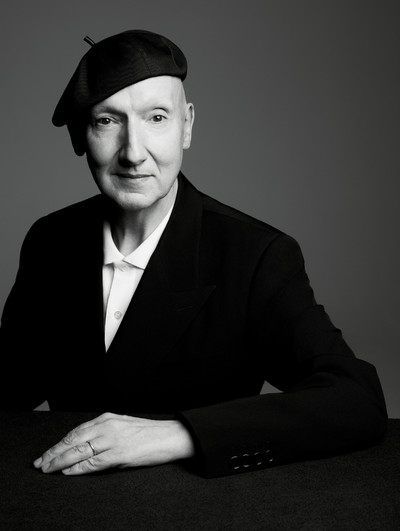
A feather in his cap – celebrating 25 years of Dior hats with master milliner Stephen Jones.
Dior Hats! is the latest exhibition to be unveiled at the Musée Christian Dior in Granville. Taking you through 70 years and 200 individual pieces of Dior’s immortal and inimitable headwear creations spanning the end of World War Two and the return of the Belle Époque, the romance of Haute Couture with Marc Bohan, the sartorial apostasy known as punk with John Galliano, the renaissance of Raf Simons, and now the fearless heroine under current creative director Maria Grazia Chiuri. The result is the visual equivalent and System’s reinterpretation of one of Chrisian Dior’s sayings: If there is no civilization without hats, then there are no hats worth considering without the house of Dior.
Of the vitrines on display lies the immeasurable body of work belonging to prolific (an adjective he humbly opts not to describe himself as) milliner Stephen Jones. Once part of Steven Strange’s London ‘Blitz Kids’ in the late 70s and early 80s, Jones was thrown out of the nest by mentor at the time, Shirley Hex, no stranger to the world of millinery having also taught the likes of Irish hat designer, Philip Treacy. Hex told Jones that he had to make his own way, forge his own path and conquer his own style. This led to his fascination with the New Romantics age post-punk and the creations of his frivolous fez’s segueing to Jones’ pre-Dior work under cult figures and labels such as Fiorucci, Jean Paul Gaultier, Thierry Mugler, Claude Montana, and of course transitioning into the blurred and blackened mainstream of Rei Kawakubo’s Comme des Garçons.
One could say that Stephen Jones has fitted more characters than a Martin Scorsese score. His now remarkable 25 years at Dior redefines timelessness in an industry that can often appear unkind in commemorating longevity. Having created for the John Galliano, Raf Simons, and now Maria Grazia Chiuri tenures at Dior respectively, the one constant that remains indisputable is that Stephen Jones has never run out of ideas. Let’s not forget he has also designed hats for current men’s artistic director of Dior, Kim Jones. System caught up with the master milliner to discuss the exhibition, his panorama of femininity traversing multiple eras for multiple designers at times simultaneously, and designing for the ‘who’ and not the ‘what.’
The exhibition shows your wonderful 25 years of hat making at Dior. When you started under John Galliano’s tenure in 1996, did you ever consider the notion of designing for posterity and your body of work subsequently belonging to an industry that, at times, can appear forgetful of longevity?
Stephen Jones: Absolutely not! Back then it felt like such a challenge. In a way it still is. The next show will always be the next challenge. I never thought I would feature throughout exhibitions in institutions such as The Met and the V&A. At that time, fashion exhibitions really weren’t as big a thing as they are now. We were so busy in 1996, working with John because also what people forget is that we were actually doing two houses. We were doing John Galliano men’s and women’s collections and we were doing Dior couture, prêt-a-porter’s, and everything else that came with it. The volume of work was enormous. We just focused on the ‘then now’ and took each collection one at a time.
Millinery is such a bespoke form of creativity. It’s for a very specific clientele. How does the design process differ between ready-to-wear and couture? The lines, or disparity in design must appear quite blurred at times!
Stephen Jones: There’s really a lot of similarities. The most important thing is how does a hat make the person look? How does it make the person feel? How does it tell the story? I apply those questions to every collection. But what’s very different has been working through the eras at Dior, first with John, then Raf Simons, and now Maria Grazia Chiuri. That’s the big difference between the prêt-a-porter and the couture. It’s the ‘who’ and not the ‘what.’
‘It’s not only in fashion but so many people in the creative industries are creating their own world because they would rather avoid the world they were born into.’
Talk me through the exhibition. It’s in The Christian Dior Museum in Granville and it spans the near-entirety of the house’s hat designs. 70 years of hat making equates 70 years of different stylistic periods. Why now?
Stephen Jones: Well, it was probably over 10 years ago that I said this to Sidney Toledano, who was the president of Dior and to John Galliano. I said, ‘there’s been nothing written about hats! Dior has this huge history with hats.’ They said, ‘well, don’t tell us, show us! You should research and look into it. You’re the one!’ Surprisingly, Soizic Pfaff, who’s the head of Dior Héritage said ‘Stephen, we will make all our facilities available to you.’ So I started my research as there hadn’t yet been a story written on it. Along the way, we made so many different discoveries. For a start, Christian Dior was a hat designer before he was a fashion designer. We didn’t know that so many of the sketches he did still existed and there’s about 100 of them. There’s so many things that we didn’t know about his past which we incorporated into the exhibition.
How long did the research process take? I suppose it never really stops?
Stephen Jones: It’s still going on! In terms of specifically for the exhibition, the last things we researched arrived about three weeks before the museum opening. We were offered the personal notebooks that belonged to the first head of the hat workroom at Dior. What was incredible was that she had little sketches under the names of the dresses. For instance, there was The Bar silhouette and there were all these different iconic outfits that we know the names of and there were the hat sketches to accompany them.
‘It’s got a little ticket on it that says: ‘Pêche du jour. Catch of the day. 1 euro.’ That was one of my favorite hats for Galliano because it’s the most ridiculous, which I love.’
You’ve designed hats under the John Galliano, Raf Simons, and now Maria Grazia Chiuri eras at Dior. Obviously there was always a respect for past designers through the likes of Marc Bohan and Gianfranco Ferré. All have shown their different interpretations of femininity through Dior. How has your interpretation of femininity developed through your 25 years at Dior?
Stephen Jones: Good question. My interpretation of femininity remains as varied as I always thought it was. In my world, femininity can be strength, it can be softness, it can be sexuality, it can be neutrality. My designs embody this panorama of femininity that I believe in. In a way, femininity, masculinity and all the polls between are still the same. It depends on what we consider femenine. Is femininity a big lace dress with flowers on? Yes, if you’re considering it like that, but those are the established rules that our parents and our grandparents thought of. Disappointment, hope, dreams, sadness, avant-garde, classism represent these different pillars I work between. Femininity is transcendent of something as simple as beauty.
So the ideal of creativity through femininity and beauty could also thrive on negativity?
Stephen Jones: Absolutely. It would be lovely if we only created from a positive point of view, but we are famously able to create from a negative perspective which is just as strong. If you look at the work of Lee McQueen, you are able to see the beauty that comes from negativity and him trying to create something in spite of homosexuality, depression, misunderstanding of identity, parental pressure and all of those things. It’s not only in fashion but so many people in the creative industries are creating their own world because they would rather avoid the world they were born into.
Can you recall some of your favorite hat designs for each designer? Let’s start with Galliano?
Stephen Jones: For John, it’s the hat in the exhibition. It’s actually this bouquet of sardines on the head, which were made out of green lizard skin. It’s got a little ticket on it that says: ‘Pêche du jour. Catch of the day. 1 euro.’ That was one of my favorite hats for Galliano because it’s the most ridiculous, which I love.
For Simons?
Stephen Jones: My favorite hat for Raf is a bonnet in white cashmere, which has got white jasmine on it. It is beautiful, clean and elegant and very Raf but it’s absolutely modern at the same time.
For Chiuri?
Stephen Jones: For Maria Grazia, I think I’d have to say the leather beret that I did for her second season, which became a huge thing within the world of hats and fashion at-large. Suddenly it became this thing. Rihanna was wearing it but also Emily in Paris wore it too (laughs)!
‘The myth of fashion existed then, as the myth of fashion exists now. It really encapsulated who you wanted to be, rather than who you actually were.’
Which designer’s debut collection were you most surprised by? Out of curiosity, was it Raf’s? Obviously, what he did for his own label was (and still is) very much rooted in the punk, hardcore and DIY movements, whereas his fame and fabled first collection for Dior was all about his reinterpretation of the Christian Dior woman. A true homage to the house’s codes. That was coming off Galliano, who was seen as the punk couturier.
Stephen Jones: I’ll tell you all about it. This is a world exclusive! Nobody’s ever asked me that before. So the first hat I did for John was really important because it was the first hat I did for Dior. It was look number one. It was John’s hat that he wore himself. I used the same block, the same straw, the same everything. It was John’s hat in the Prince of Wales check. It was worn with a Prince of Wales check suit which he also wore in his press picture. It was the same for the Dior woman as it was for him. I remember, he wore it with an orchid in the lapel. The first hat I did for Raf was so interesting. He considered the veil. He always said it was a symbol of mid-century elegance. So when the girls came out for the first couture show, they didn’t have veils on their heads. When they came out for the finale, they all had veils on which I had sourced from around the world. They were all vintage veils, either made in the 30s, or the 60s, which were the most modernist weaves that they could do. I asked him why veils at the end of the show and he said that he was always into them. He got me his portfolio of his college work from his parents’ house and throughout, all the girls had veils on.
So, if John’s Dior hats disrupted the system, Raf’s were more about balance and today your hat designs for Maria Grazia have added a youthful modernity to that balance?
Stephen Jones: For Maria Grazia, she was telling me that she wants to make hats that every young girl in the world can wear. That is our design brief. Her first collection was all about the protection of women. Some of it was based on traditional fencing outfits. So, in fact, I looked at fencing outfits as I’ve never done fencing myself. I looked at one of the fencing collars. They were these protective collars, and I thought, ‘sure, that could work on your head as a visor.’ And I got one and I put it on and it just worked. And we changed the pattern, adapted the shape, adapted the angles and everything. That became the first hat I did for Maria Grazia.
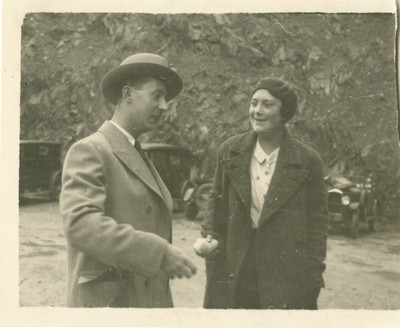
Christian Dior and his friend Suzanne Luling on the Plat Gousset in Granville. Coll. Christian Dior museum, Granville.
© Right reserved.

© Raphaël Dautigny.
‘Mr Dior famously said: ‘Without hats, there is no civilization.’
Let’s go back to the beginning. Christian Dior was responsible for this return to a newfound state of elegance post World War Two. At the time, women weren’t wearing hats due to the industrial repercussions of the war. Do you think a milliner nowadays needs to have a great understanding of history and therefore an even greater understanding of how to transition that into creativity when designing hats for houses spanning the legacy of Dior?
Stephen Jones: Of course. Like clothing, hats make sense when they correspond to the times we’re in. For example, you’re wearing a beanie because it represents the time we are living in. If you look at 40s Ferger and 50s Harper’s Bazaar images, there was this myth that everybody was wearing a Brogden brimmed hat with a veil and flowers on. No, they were not! They were wearing a little beret, or a little hat because they were taking their children to school, or kissing each other. The myth of fashion existed then, as the myth of fashion exists now. It really encapsulated who you wanted to be, rather than who you actually were. These women coming out of wartime had been eating rats and suddenly they were in a big brimmed hat and it felt like a wonderful dream. So in fact, the hats that Monsieur Dior designed before he opened his house were full of character. The way Dior did hats was actually quite simple. They were a reflection of social commentary – a perfect combination of fantasy and reality. He didn’t think of the hat as being something separate to the rest of the clothing. Mr Dior famously said: ‘Without hats, there is no civilization.’
Speaking of designing hats to reflect the times we’re living in, you’ve designed hats for different designers, spanning different stylistic movements, at times rather simultaneously! Let’s briefly talk about the punk era and one that you were a trailblazer in. You aestheticized that with Galliano. Whilst emanating a form of rebellion against fashion, punk silhouettes have retained a rigid discipline in design. Punk opted to ‘embellish,’ or ‘dismantle’ a heritaged silhouette rather than create an outwardly outrageous piece of clothing. Did you follow a similar ideology when designing hats during that era?
Stephen Jones: I mean when we look back at punk, what was so fascinating about it was that I remember looking at old Vogue magazines from 1976 in the library. There were 50s fashion models in Henry Clarke pictures and they were sneering at the public. They felt completely superior in the same way that Siouxsie Sioux or Johnny Rotten did. It was very much the same mentality. They were striking a pose like those punk singers were. People tend to think that punk was about being all over the place or not caring. Oh my God, no! Absolutely not. As you said, it was a complete discipline. It wasn’t about wearing a pair of ripped jeans. It’s about being spot on all the time. Punk was a religion.
‘It doesn’t matter whether you’re an industry person or you’re living in a faraway land and you don’t know anything about fashion. If you put a hat on, you enter the world of Paris fashion.’
The British intellection of punk was not that dissimilar from that of dandyism. Let’s call it an iconoclastic social commentary…
Stephen Jones: Exactly. Look at how Beau Brummell would spend time after time perfecting his white tie. Is that very different to Soo Catwoman putting a safety pin through her nose?
You’ve designed hats for everyone. Hamish Bowles, Carla Bruni, Céline Dion, Mick Jagger, Rihanna, just to name a few. The list is endless and it defines timelessness. Have you ever been nervous when designing hats for celebrities?
Stephen Jones: I’m always nervous when I’m designing hats full stop!
Finally, what does the Chapeaux Dior! exhibition reveal about the realness of fashion?
Stephen Jones: It doesn’t matter whether you’re an industry person or you’re living in a faraway land and you don’t know anything about fashion. If you put a hat on, you enter the world of Paris fashion.
Chapeaux Dior! is open at Musée Christian Dior – Granville from May 14 to October 30, 2022.
